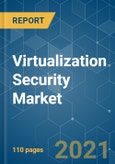The Virtualization Security Market was valued at USD 0.97 billion in 2020 and is expected to reach USD 2.28 billion by 2026, at a CAGR of 15.2% over the forecast period 2021 - 2026. Virtualization has made a huge impact in a very short time in the IT and networking domains and has already provided huge cost savings and returns on investments for data centers, enterprises, and the Cloud. The new environment is more complex, and virtualization approaches added to current networks creates a new network that needs a new approach to security.
Key Market Trends
IT & Telecom is Expected to Hold a Major Market Share.
North America is Expected to Hold a Major Market Share During the Forecast Period
Competitive Landscape
The virtualization security market consists of several major players. In terms of market share, none of the players currently dominate the market. The companies have been focussing on product innovation in order to gain a competitive advantage.
Reasons to Purchase this report:
This product will be delivered within 2 business days.
- The increasing amount of server loads has caused a huge problem to enterprises. The introduction of virtualization makes the handling of server load easy and thus, benefits the organization in terms of expenses and time.
- Hardware reductions occur due to virtualization which in turn, improves physical security since there are fewer devices and ultimately fewer data centers. Therefore the adoption of virtualization gives a boost and thus, boosting the market for virtualization security.
Key Market Trends
IT & Telecom is Expected to Hold a Major Market Share.
- For every telecom operator, network agility is a prerequisite for sustainable success. Operators who are able to instantly scale capacity and performance to demand will take the lead. There is a need to personalize their networks, delivering winning new products and services ahead of the competition, and achieving a stand-out position in customer satisfaction.
- Telecoms networks contain a continuously increasing wide array of proprietary hardware appliances. The launch a new network service often requires yet another appliance and finding the space and power to accommodate these boxes is becoming increasingly difficult, in addition to the complexity of integrating and deploying these appliances in a network. This has lead to substantial adoption rates of Virtualization and indeed lead to the massive adoption of virtualization security solutions.
- Seven of the world’s leading telecoms network operators initiated ETSI Industry Specification Group (ISG) for Network functions virtualization (NFV). These have been quickly joined by over 280 companies including network operators, telecoms equipment vendors, IT vendors, and technology providers. ETSI has created the NFV ISG to define the requirements and architecture for the virtualization of network functions and to address their technical challenges.
North America is Expected to Hold a Major Market Share During the Forecast Period
- With the recent significant increase in the Information Technology services in the United States, the load on the servers have increased substantially. With the increasing competition between the IT firms, there is instant need to upgrade the technology in order to gain a competitive advantage.
- The focus of the organizations has shifted from infrastructure to information. The costs involved and shortchanging are the business functions which the organizations are focussing in.
- An immense amount of data has been generating in developed regions like Canada and the United Staes. Organizations in the United States are searching for better ways to store, manage, protect and use their data, including private clouds or hybrid clouds that combine on-premises and cloud storage for higher flexibility at a lower cost.
- Businesses tend to gain significant capital and operational efficiencies through virtualization because it leads to improved server utilization and consolidation, dynamic resource allocation and management, workload isolation, security, and automation. Virtualization makes on-demand self-provisioning of services and software-defined orchestration of resources possible, scaling anywhere in a hybrid cloud on-premise or off-premise per specific business needs.
Competitive Landscape
The virtualization security market consists of several major players. In terms of market share, none of the players currently dominate the market. The companies have been focussing on product innovation in order to gain a competitive advantage.
- December 2017 - The OpenStack Foundation announces a new open source project, Kata Containers, which aims to unite the security advantages of virtual machines (VMs) with the speed and manageability of container technologies.
- March 2019 - Microsoft has introduced Azure Stack HCI Solutions, a new implementation of its on-premises Azure product specifically for Hyper Converged Infrastructure (HCI) hardware.
Reasons to Purchase this report:
- The market estimate (ME) sheet in Excel format
- 3 months of analyst support
This product will be delivered within 2 business days.
Table of Contents
1 INTRODUCTION
4 MARKET DYNAMICS
5 MARKET SEGMENTATION
6 COMPETITIVE LANDSCAPE
Companies Mentioned (Partial List)
A selection of companies mentioned in this report includes, but is not limited to:
- VMware Inc.
- Broadcom Inc.
- Hewlett Packard Enterprise Development LP
- Dell Inc.
- Telefonaktiebolaget LM Ericsson
- Altor Networks
- Trend Micro Inc.
- Oracle corporation
Methodology

LOADING...








